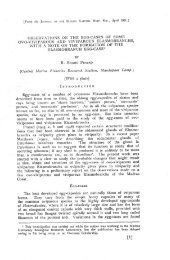PDF - Eprints@CMFRI
PDF - Eprints@CMFRI
PDF - Eprints@CMFRI
Create successful ePaper yourself
Turn your PDF publications into a flip-book with our unique Google optimized e-Paper software.
72<br />
Family Siderastreidae VAUGHA and WELLS , 1943<br />
Key to the genera of the family ftom Red Sea :<br />
1. Encrusting or massive. Corallites cerioid, polygonal; wall formed of several layers of synapticulae.<br />
Budding extratentacular. Corallite wall well defined . ........... . ... . ......... .. . . Siderastrea<br />
2. Encrusting to massive. Corallite wall not well defined. Calices single or in short series thus meandroid<br />
co nfluent. Budding intratentacular, mono- to tristomodaeal. . . , ' .. ............ . ... Coscinaraea<br />
Genus Siderastrea de BLAINVILLE, 1830<br />
Ty pes pee i e s : Madrepora radians PALLAS, 1766.<br />
G e n e ric c h a r act e r s: Submassive or encrusting. Corallites cerioid, wall thin, corallites polygonal.<br />
Septa uniting, two rows o f synapticulae visible within the calyx. Septal edges dentate, sides granular.<br />
Columella small, papillary.<br />
KLUNZ I GER (1879) described two species of Siderastrea from Red Sea viz . S. savignyana and S.<br />
lilacea. The distinction between these two is minor. HORST (1922) felt that these two are one and the<br />
same. (Though his specimens, described 1921 , did not belong to S. savignyana but are only Pseudosiderastrea<br />
tayami.) We agree with HORST (1922) that the two Red Sea species of Siderastrea belong to a single<br />
species, as described below.<br />
Siderastrea savignyana MILNE EDWARDS and HAIM E, 1850<br />
(Plate 15. Figs. 5 , 6)<br />
Aslraea SQvignyana 1857. MILNE EDWARDS ( & HAIME). 508 (Type loc ality : Red Su).<br />
SideriJstriJea savignyana 1879, KLVNZINCER 3, 77.<br />
1922. v. d. HORST. 423.<br />
1954, ROSSI, 42.<br />
1980, HEAD. I SO, 451.<br />
Astrea ga/JJxea 1828, AUDOUIN (& SAVIGNV1 . 57; pI. 5/ 1.<br />
S ideraslraea li/Qu a 1879. KLUNZINGER 3. 77 ; pI s. 9/6 ; 101162, b.<br />
1971 , LOVA & SLOBODKIN, 123.<br />
pulchella r 1888, FAUROT, 11 9.<br />
savignyi 1892. RE HBERG, 24.<br />
SLR 832 and SLR 856- 2 are thick encrustations. Maximum thickness about 1.5 cm. Calices polygonal,3<br />
to 4 mm in length, 2 to 2.5 mm wide, about 1.5 mm deep. Total septa 30 to 35 in a fully grown<br />
calyx, of equal thickne s at the wall. Higher cycles unite to the lower, 12 septa unite the columella. Septal<br />
edges with subequal dentation. Intercorallite wall about 1 mm thick, often with a sharp ridge at the middle.<br />
EC 362 is a massive, free lying colony. The intercorallite wall only 0.5 mm in thickness. 4 to 6 papillary<br />
projections are seen around the central columella style. Other details as already described.<br />
Material :<br />
Gulf of Suez: Jerus. SLR 832,856- 2 (Et Tur).<br />
Gulf of Aqaba: Basel PW 71355 (Fara'un lsI., 40 m).<br />
Southern R . S.: HLM EC 362 (Massawa).<br />
Di s t r i b uti 0 n : Red Sea; East Africa.<br />
Rem ark s : ORTMANN's (1889) Siderastraea spbaeroidalis, which he mentioned 1892 from Red Sea<br />
under the name S. savignyana, belongs, according to v. d. HORST (1922: 420), to Pavona clavus.<br />
Another Siderastrea from Red Sea, reported by FAUROT (1888), is S. pulcbella MILNE EDWARDS &<br />
HAIME . We put this coral to S. savignyana, because the latter is the only species of Siderastrea known<br />
from Red Sea.
















